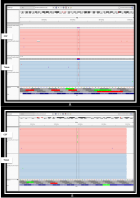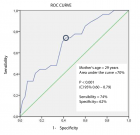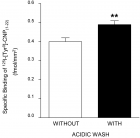Abstract
Research Article
Predicting physical symptoms through expressions of loneliness and anxiety in individuals utilizing social media during SARS-CoV-2
Vasiliki Georgoulas-Sherry*
Published: 25 April, 2022 | Volume 6 - Issue 1 | Pages: 011-017
The effect of the novel coronavirus (SARS-CoV-2) pandemic has produced significant health concerns negatively impacting individuals. As the ongoing and constantly changing nature of SARS-CoV-2 continues, the unique characteristics of this pandemic trend toward anxiety and loneliness as significant behavioral health outcomes. Furthermore, the SARS-CoV-2 pandemic has significantly impacted the utilization of social media platforms such as Twitter. Utilizing over 1.6 million tweets from approximately 988,760 Twitter users geolocated in Washington state from the University of Pennsylvania’s publicly available Twitter database (from March 2020 to March 2021), this study evaluated the impact of SARS-CoV-2 by using expressions of loneliness and anxiety to predict mental and physical symptoms. Bivariate correlations revealed expressions of loneliness were correlated to trouble breathing while expressions of anxiety were correlated to skin lesions, body aches, flu-like, seasonal cold, trouble breathing, nausea or diarrhea, fever, chills, and cough. Multiple multivariate linear regressions were completed, and a significant regression equation was found in predicting trouble breathing symptoms on expressions of loneliness and anxiety, however, the proportion of variance was 8% of the observed variation in the model. Further implications revealed the importance of understanding mental and physical well-being during a public health crisis as well as the use of social media platforms as primary and supplementary stimuli.
Read Full Article HTML DOI: 10.29328/journal.ida.1001031 Cite this Article Read Full Article PDF
Keywords:
Physical symptoms; Loneliness; Anxiety; Mental health; Social media
References
- Bryant-Genevier J, Rao CY, Lopes-Cardozo B, Kone A, Rose C, et al. Symptoms of depression, anxiety, post-traumatic stress disorder, and suicidal ideation among state, tribal, local, and territorial public health workers during the COVID-19 Pandemic—United States. March–April 2021. MMWR Morb Mortal Wkly Rep. 2021; 70: 947–952. PubMed: https://pubmed.ncbi.nlm.nih.gov/34197362/
- Cauberghe V, Van Wesenbeeck I, De Jans S, Hudders L, Ponnet K. How adolescents use social media to cope with feelings of loneliness and anxiety during COVID-19 lockdown. Cyberpsychol Behav Soc Netw. 2021; 24: 250–257. PubMed: https://pubmed.ncbi.nlm.nih.gov/33185488/
- Guntuku SC, Sherman G, Stokes DC, Agarwal AK, Seltzer E, et al. Tracking mental health and symptom mentions on twitter during COVID-19. J Gen Intern Med. 2020; 35: 2798–2800. PubMed: https://pubmed.ncbi.nlm.nih.gov/32638321/
- Jia H, Guerin RJ, Barile JP, Okun AH, McKnight-Eily L, et al. National and state trends in anxiety and depression severity scores amongst adults during the COVID-19 Pandemic—United States, 2020–2021. MMWR Morb Mortal Wkly Rep. 2020; 70: 1427–1432. PubMed: https://pubmed.ncbi.nlm.nih.gov/34618798/
- McKnight-Eily LR, Okoro CA, Strine TW, Verlenden J, Hollis ND, et al. Racial and ethnic disparities in the prevalence of stress and worry, mental health conditions, and increased substance use among adults during the COVID-19 pandemic—United States, April and May 2020. MMWR Morb Mortal Wkly Rep. 2021; 70: 162–166. PubMed: https://pubmed.ncbi.nlm.nih.gov/33539336/
- Palgi Y, Shrira A, Ring L, Bodner E, Avidor S, et al. The loneliness pandemic: Loneliness and other concomitants of depression, anxiety and their comorbidity during the COVID-19 outbreak. J Affect Disord. 2020; 275: 109-111. PubMed: https://pubmed.ncbi.nlm.nih.gov/32658811/
- Vahratian A, Blumberg SJ, Terlizzi EP, Schiller JS. Symptoms of anxiety or depressive disorder and use of mental health care among adults during the COVID-19 Pandemic - United States, August 2020–February 2021. MMWR Morb Mortal Wkly Rep. 2021; 70: 490–494. PubMed: https://pubmed.ncbi.nlm.nih.gov/33793459/
- Barbosa C, Cowell AJ, Dowd WN. Alcohol consumption in response to the COVID-19 pandemic in the United States. J Addict Med. 2021; 15: 341– PubMed: https://pubmed.ncbi.nlm.nih.gov/33105169/
- Da Silva FR, Junior AHL, Brant VM, Lôbo ILB, Lancha LOP, et al. The effects of COVID-19 quarantine on eating and sleeping behaviors. Nutrire. 2020; 45: 25. PubMed: https://www.ncbi.nlm.nih.gov/pmc/articles/PMC7523687/
- Kendzerska T, Zhu DT, Gershon AS, Edwards JD, Peixoto C, et al. The effects of the health system response to the COVID-19 pandemic on chronic disease management: a narrative review. Risk Manag Healthc Policy. 2021; 14: 575–584. PubMed: https://pubmed.ncbi.nlm.nih.gov/33623448/
- Kneer K, Reinhard J, Ziegler C, Slyschak A, Schiele M, et al. Serotonergic influence on depressive symptoms and trait anxiety is mediated by negative life events and frontal activation in children and adolescents. Eur Child Adolesc Psychiatry. 2020; 29: 691–706. PubMed: https://pubmed.ncbi.nlm.nih.gov/31422473/
- Løhre A, Lydersen S, Vatten LJ. School wellbeing among children in grades -10. BMC Public Health. 2010; 10: 1–7.
- Dalal N, Kathad A, Masurkar S, Pavithran S, Soumyanarayan T. Correlation studies between Big Five Personality traits, age and loneliness. Indian J Mental Health. 2018; 5: 32.
- Holt-Lunstad J, Smith TB, Baker M, Harris T, Stephenson D. Loneliness and social isolation as risk factors for mortality: a meta-analytic review. Perspecti Psychol Sci. 2015; 10: 227– PubMed: https://pubmed.ncbi.nlm.nih.gov/25910392/
- Nangle DW, Erdley CA, Newman JE, Mason CA, Carpenter EM. Popularity, friendship quantity, and friendship quality: Interactive influences on children's loneliness and depression. J Clin Child Adolesc Psychol. 2003; 32: 546–555. PubMed: https://pubmed.ncbi.nlm.nih.gov/14710463/
- Mihalopoulos C, Le LKD, Chatterton ML, Bucholc J, Holt-Lunstad J, et al. The economic costs of loneliness: A review of cost-of-illness and economic evaluation studies. Soc Psychiatry Psychiatr Epidemiol. 2020; 55: 823–836. PubMed: https://pubmed.ncbi.nlm.nih.gov/31119308/
- O’Day EB, Heimberg RG. Social media use, social anxiety, and loneliness: A systematic review. Computers Human Behav Rep. 2021; 3: 100070.
- Pittman M. Creating, consuming, and connecting: Examining the relationship between social media engagement and loneliness. J Soc Media Soc. 2015; 4: 66– https://www.thejsms.org/index.php/JSMS/article/download/92/52
- Frasure-Smith N, Lesperance F. Depression and anxiety as predictors of 2-year cardiac events in patients with stable coronary artery disease. Arch Gen Psychiatry. 2008; 65: 62–71. PubMed: https://pubmed.ncbi.nlm.nih.gov/18180430/
- Bryan JL, Baker ZG, Tou RY. Prevent the blue, be true to you: Authenticity buffers the negative impact of loneliness on alcohol-related problems, physical symptoms, and depressive and anxiety symptoms. J Health Psychol. 2017; 22: 605–616. PubMed: https://pubmed.ncbi.nlm.nih.gov/26490626/
- Larson GE, Booth-Kewley S, Merrill LL, Stander VA. Physical symptoms as indicators of depression and anxiety. Mil Med. 2001; 166: 796–799. PubMed: https://pubmed.ncbi.nlm.nih.gov/11569444/
- Hawkley LC, Masi CM, Berry JD, Cacioppo JT. Loneliness is a unique predictor of age-related differences in systolic blood pressure. Psychol Aging. 2006; 21: 152-164. PubMed: https://pubmed.ncbi.nlm.nih.gov/16594800/
- Hawkley LC, Thisted RA, Cacioppo JT. Loneliness predicts reduced physical activity: Cross-sectional & longitudinal analyses. Health Psychol. 2009; 28: 354 –363. PubMed: https://pubmed.ncbi.nlm.nih.gov/19450042/
- Hawkley LC, Thisted RA, Masi CM, Cacioppo JT. Loneliness predicts increased blood pressure: 5-year cross-lagged analyses in middle-aged and older adults. Psychol Aging. 2010; 25: 132–140. PubMed: https://pubmed.ncbi.nlm.nih.gov/20230134/
- Cacioppo JT, Hughes ME, Waite LJ, Hawkley LC, Thisted RA. Loneliness as a specific risk factor for depressive symptoms: Cross-sectional and longitudinal analyses. Psychol Aging. 2006; 21: 140–151. PubMed: https://pubmed.ncbi.nlm.nih.gov/16594799/
Figures:

Figure 1
Similar Articles
-
Burnout and Related Factors in Caregivers of outpatients with SchizophreniaHatice Demirbas*,Erguvan Tugba Ozel Kizil. Burnout and Related Factors in Caregivers of outpatients with Schizophrenia. . 2017 doi: 10.29328/journal.hda.1001001; 1: 001-011
-
Anxiety and depression as an effect of birth order or being an only child: Results of an internet survey in Poland and GermanyJochen Hardt*,Lisa Weyer,Malgorzata Dragan,Wilfried Laubach. Anxiety and depression as an effect of birth order or being an only child: Results of an internet survey in Poland and Germany. . 2017 doi: 10.29328/journal.hda.1001003; 1: 015-022
-
Spiritual and religious Islamic perspectives of healing of posttraumatic stress disorderMevludin Hasanović*,Izet Pajević,Osman Sinanović. Spiritual and religious Islamic perspectives of healing of posttraumatic stress disorder. . 2017 doi: 10.29328/journal.hda.1001004; 1: 023-029
-
Vestibular-limbic relationships: Brain mappingPaolo Gamba*. Vestibular-limbic relationships: Brain mapping. . 2018 doi: 10.29328/journal.ida.1001006; 2: 007-013
-
Responding to Disasters: More than economic and infrastructure interventionsDavid Crompton OAM*,Ross Young,Jane Shakespeare-Finch,Beverley Raphael AM. Responding to Disasters: More than economic and infrastructure interventions. . 2018 doi: 10.29328/journal.ida.1001007; 2: 014-028
-
Anti-anxiety effects in mice following acute administration of Ficus Thonningii (wild fig)Aduema W*,Akunneh-Wariso C,Ejiofo DC,Amah AK. Anti-anxiety effects in mice following acute administration of Ficus Thonningii (wild fig). . 2018 doi: 10.29328/journal.ida.1001009; 2: 040-047
-
Translation, adaptation and validation of Depression, Anxiety and Stress Scale in UrduWaqar Husain*,Amir Gulzar. Translation, adaptation and validation of Depression, Anxiety and Stress Scale in Urdu. . 2020 doi: 10.29328/journal.ida.1001011; 4: 001-004
-
Depression as a civilization-deformed adaptation and defence mechanismBohdan Wasilewski*,Olha Yourtsenyuk,Eugene Egan. Depression as a civilization-deformed adaptation and defence mechanism. . 2020 doi: 10.29328/journal.ida.1001013; 4: 008-011
-
The different levels of depression and anxiety among Pakistani professionalsSehrish Hassan*,Waqar Husain. The different levels of depression and anxiety among Pakistani professionals. . 2020 doi: 10.29328/journal.ida.1001014; 4: 012-018
-
Impact of Christian meditation and biofeedback on the mental health of graduate students in seminary: A pilot studyPaul Ratanasiripong*,Sun Tsai . Impact of Christian meditation and biofeedback on the mental health of graduate students in seminary: A pilot study. . 2020 doi: 10.29328/journal.ida.1001015; 4: 019-024
Recently Viewed
-
The Bacteriological Profile of Nosocomial Infections at the Army Central Hospital of BrazzavilleMedard Amona*,Yolande Voumbo Matoumona Mavoungou,Hama Nemet Ondzotto,Benjamin Kokolo,Armel Itoua,Gilius Axel Aloumba,Pascal Ibata. The Bacteriological Profile of Nosocomial Infections at the Army Central Hospital of Brazzaville. Int J Clin Microbiol Biochem Technol. 2025: doi: 10.29328/journal.ijcmbt.1001032; 8: 009-022
-
Comparative Study of Enophthalmos Treatment with Titanium Mesh Combined with Absorbable Implant vs. Costochondral Graft for Large Orbital Defects in Floor FracturesMalagón Hidalgo*,Héctor Omar,González Magaña,Fernando, Kalach Mussali,Alberto Jaime,Mejía Valero,Sergio Abraham,Vilchis López,Roberto,Araiza Gómez,Edgardo,Kalach Mussali. Comparative Study of Enophthalmos Treatment with Titanium Mesh Combined with Absorbable Implant vs. Costochondral Graft for Large Orbital Defects in Floor Fractures . J Oral Health Craniofac Sci. 2017: doi: 10.29328/journal.johcs.1001007; 2: 022-29
-
The Role of Genetic Mutations in the HPGD & SLCO2A1 Genes in Pachydermoperiostosis SyndromeShahin Asadi*,Arezo Zare,Sima Koohestani. The Role of Genetic Mutations in the HPGD & SLCO2A1 Genes in Pachydermoperiostosis Syndrome. J Genet Med Gene Ther. 2025: doi: 10.29328/journal.jgmgt.1001013; 8: 001-005
-
Impact of Latex Sensitization on Asthma and Rhinitis Progression: A Study at Abidjan-Cocody University Hospital - Côte d’Ivoire (Progression of Asthma and Rhinitis related to Latex Sensitization)Dasse Sery Romuald*, KL Siransy, N Koffi, RO Yeboah, EK Nguessan, HA Adou, VP Goran-Kouacou, AU Assi, JY Seri, S Moussa, D Oura, CL Memel, H Koya, E Atoukoula. Impact of Latex Sensitization on Asthma and Rhinitis Progression: A Study at Abidjan-Cocody University Hospital - Côte d’Ivoire (Progression of Asthma and Rhinitis related to Latex Sensitization). Arch Asthma Allergy Immunol. 2024: doi: 10.29328/journal.aaai.1001035; 8: 007-012
-
Cytokine intoxication as a model of cell apoptosis and predict of schizophrenia - like affective disordersElena Viktorovna Drozdova*. Cytokine intoxication as a model of cell apoptosis and predict of schizophrenia - like affective disorders. Arch Asthma Allergy Immunol. 2021: doi: 10.29328/journal.aaai.1001028; 5: 038-040
Most Viewed
-
Impact of Latex Sensitization on Asthma and Rhinitis Progression: A Study at Abidjan-Cocody University Hospital - Côte d’Ivoire (Progression of Asthma and Rhinitis related to Latex Sensitization)Dasse Sery Romuald*, KL Siransy, N Koffi, RO Yeboah, EK Nguessan, HA Adou, VP Goran-Kouacou, AU Assi, JY Seri, S Moussa, D Oura, CL Memel, H Koya, E Atoukoula. Impact of Latex Sensitization on Asthma and Rhinitis Progression: A Study at Abidjan-Cocody University Hospital - Côte d’Ivoire (Progression of Asthma and Rhinitis related to Latex Sensitization). Arch Asthma Allergy Immunol. 2024 doi: 10.29328/journal.aaai.1001035; 8: 007-012
-
Causal Link between Human Blood Metabolites and Asthma: An Investigation Using Mendelian RandomizationYong-Qing Zhu, Xiao-Yan Meng, Jing-Hua Yang*. Causal Link between Human Blood Metabolites and Asthma: An Investigation Using Mendelian Randomization. Arch Asthma Allergy Immunol. 2023 doi: 10.29328/journal.aaai.1001032; 7: 012-022
-
An algorithm to safely manage oral food challenge in an office-based setting for children with multiple food allergiesNathalie Cottel,Aïcha Dieme,Véronique Orcel,Yannick Chantran,Mélisande Bourgoin-Heck,Jocelyne Just. An algorithm to safely manage oral food challenge in an office-based setting for children with multiple food allergies. Arch Asthma Allergy Immunol. 2021 doi: 10.29328/journal.aaai.1001027; 5: 030-037
-
Snow white: an allergic girl?Oreste Vittore Brenna*. Snow white: an allergic girl?. Arch Asthma Allergy Immunol. 2022 doi: 10.29328/journal.aaai.1001029; 6: 001-002
-
Cytokine intoxication as a model of cell apoptosis and predict of schizophrenia - like affective disordersElena Viktorovna Drozdova*. Cytokine intoxication as a model of cell apoptosis and predict of schizophrenia - like affective disorders. Arch Asthma Allergy Immunol. 2021 doi: 10.29328/journal.aaai.1001028; 5: 038-040

If you are already a member of our network and need to keep track of any developments regarding a question you have already submitted, click "take me to my Query."


















































































































































